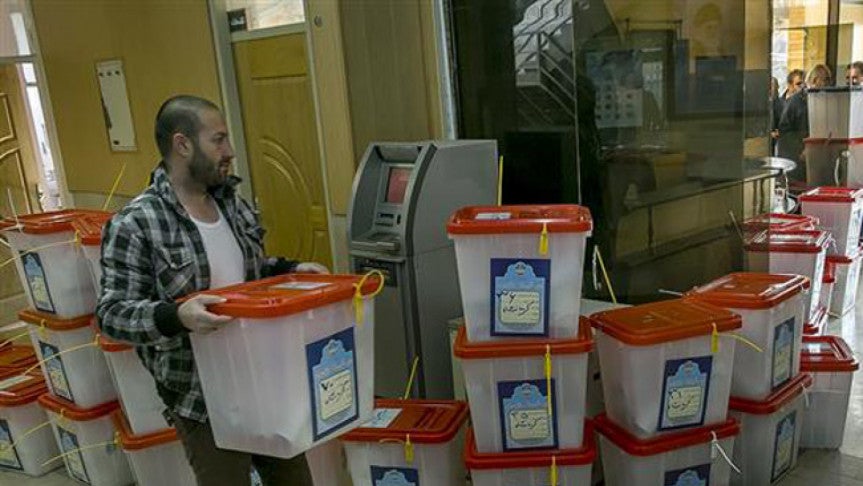Iran votes in vital elections after nuclear deal

Tehran: Iranians began voting across the country Friday in elections billed by the moderate president as vital to curbing conservative dominance in parliament and speeding up domestic reforms after a nuclear deal with world powers.
A pro-government coalition called ‘The List of Hope’ is representing President Hassan Rouhani’s ambitions in the polls. Almost 55 million people are eligible to cast ballots that will ultimately elect 290 lawmakers.
They will also vote in a second election to select the Assembly of Experts, a powerful committee of 88 clerics that monitors the work of supreme leader Ayatollah Ali Khamenei.
While MPs are elected for four years the assembly will be granted an eight-year term. Should Khamenei, who is 76, die during that time its members would pick his successor.
Voting started at 8:00am (0430 GMT) and will close at 6pm although officials say polling stations could stay open if there are queues and more time is needed to cast ballots.
Supreme leader Ayatollah Ali Khamenei cast his vote early Friday morning in a televised ceremony and urged everyone to do so ‘quickly, as it’s both a duty and a right’.
‘Everyone must vote, those who love Iran, those who like the Islamic Republic, those who love the grandeur and glory of Iran,’ he told a state television reporter after casting his vote.
‘We have enemies. Elections should be such that make the enemy disappointed. We must vote with insight and open eyes.’
As Iran’s ultimate authority, Khamenei’s powers outrank those of Rouhani, but the president is looking for gains in parliament to allow him to build on the nuclear deal by bringing improvements at home.
The economy has featured strongly during the election campaign as Iran faces a stubborn challenge to overcome the damage that almost a decade of sanctions caused.
The elections will be a crucial indicator of the future direction Iranians want for their country.
‘I expect the situation of the country to improve through reforms,’ Atefeh Yousefi, 38, told AFP while waiting in line at a polling station in Tehran, adding that she regretted boycotting elections in the past.
Rouhani has played up the potential for foreign investment which he says will bring jobs, particularly for Iran’s youth whose unemployment rate of 25 per cent is two-and-a-half times the national average.
However, conservatives say strong economic growth will only be possible if an emphasis is placed on domestic production under a ‘resistance economy’ model more in tune with the ideals of Iran’s 1979 Islamic revolution.
Voting figures and methods
Iranians are voting Friday to elect 290 members of parliament and 88 members of the Assembly of Experts, a panel of clerics responsible for appointing and monitoring Iran’s supreme leader.
Number of voters: 54,915,024 are eligible to cast ballots, 8,475,077 of them in Tehran province, according to the interior ministry. Iran’s population is around 79 million.
A total of one million people will be mobilised to organise and run the elections, and around 250,000 policemen will be on duty.
In each polling station, apart from representatives of the interior ministry and the Guardian Council, a constitutional watchdog, officials of other state bodies, including the police, will also be present.
Candidates may have observers in polling stations.
The interior ministry is responsible for organising the elections, while the Guardian Council (made up of six clerics appointed by the supreme leader and six jurists recommended by the judiciary) is responsible for supervising the polls.
Number of parliamentary candidates: 4,844, about 10 percent of whom are women, were approved by the Guardian Council -- only 40 percent of the approximately 12,000 who initially registered to run. The percentage fell markedly after 1,385 previously approved candidates withdrew less than 48 hours before polling day.
For the Assembly of Experts, the Guardian Council approved 159 candidates to contest the 88 seats of the chamber, out of 800 who applied. Members are elected by single majority vote.
Two-round legislative vote: Successful candidates are elected in the first round if they obtain over 25 percent of votes cast. For each seat left empty, two runner-ups will compete in a second round, likely within two or three weeks.
In Tehran, voters elect 30 parliamentarians. In other cities, the number of MPs varies according to the population. Electors must write the full names of candidates they support on the ballot paper. In the capital, this means voters should write the names of 30 candidates on the ballot for parliament and 16 candidates for the Assembly of Experts, though many do not use their full allowance.
The painstaking procedure makes the voting process complex and the counting protracted.
The list of candidates in polling stations is displayed in alphabetical order. The location is often a school, mosque or state building where men and women vote separately. Voters are not registered and they can vote in any constituency. The only restriction is that the voter cannot change constituency between the two rounds of voting. Voters must present two identity documents, the national ID card and an Iranian document resembling a passport called Shenasnameh, which is stamped in each election, making it impossible to vote multiple times.
The results of small constituencies will be announced on Friday night, and those in provincial cities are likely on Saturday. But results will take three days in Tehran. Official final results will be announced by the interior ministry, and must be approved by the Guardian Council who can annul the vote in some constituencies.

 AFP
AFP



